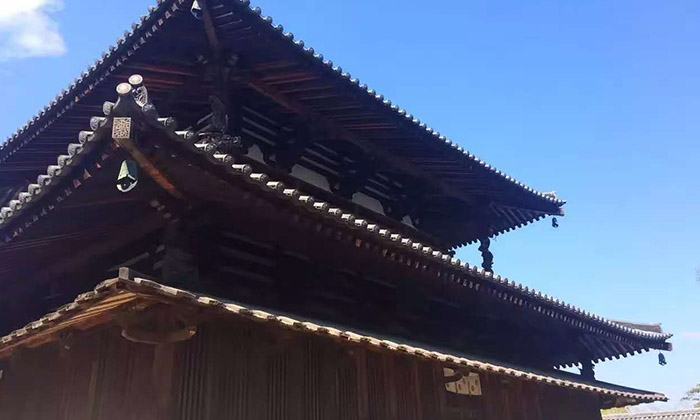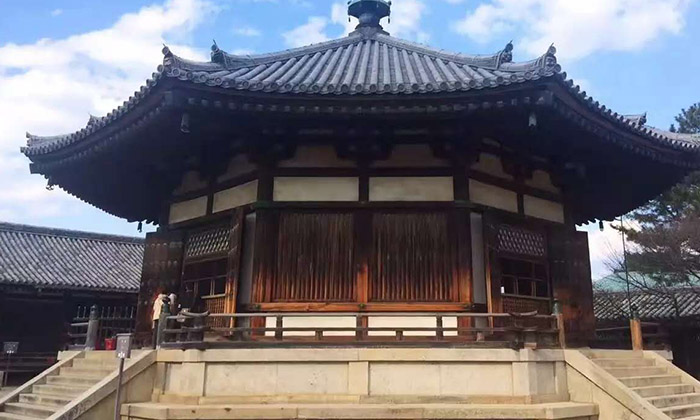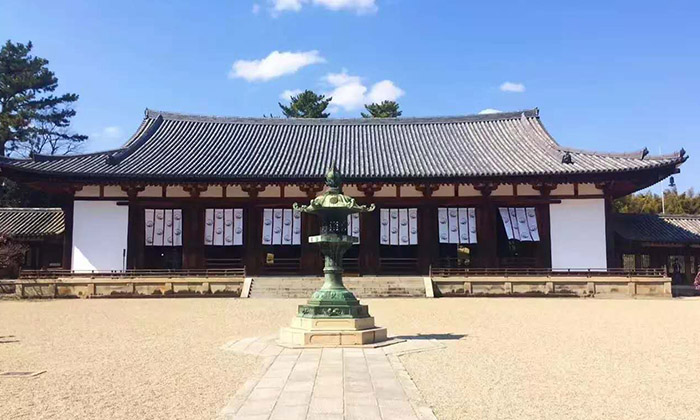Horyu-ji Temple
Horyu-ji Temple, located in Nara, is the first wooden building listed as a world cultural heritage in Japan. In 1933, it was recognized as the oldest wooden building in the world. Horyu-ji Temple was believed to be was by Prince Shotoku in 607, and is one of the oldest temples in Japan. Because it is located in Ikaruga-cho of Ikoma-gun in Nara Prefecture, it is commonly known as Ikaruga Temple. Horyu-ji Temple covers a total area of 187,000 square meters and preserved about 190 pieces of various treasures since the Asuka period.
Horyu-ji Temple is divided into east and west precincts. Eastern Precinct (Toin Garan) used to be the residence of Prince Shotoku, including a dream hall with an octagonal shape dedicated to the wooden statue "Salvation Guanyin". Western Precinct (Saiin Garan), on the other hand, has a golden hall made from wood with painting all around. There are three statues of Sakyamuni and a five-storied pagoda up to about 31 meters in the hall. Also there are lecture hall, bell tower, and a scripture tower.

Hall of Visions (Yumedono), located in the center of the Galan where the Prince Shotoku's previous residence was, was built mainly to enshrine Prince Shotoku. Hall of Visions is octagonally-shaped and was once praised as the Pearl of Architecture by German architects. The hall collected a wooden Avalokitesvara statue with the same height as Prince Shotoku, made at the first half of the 7th century. In the Hall of Visions hosts from 4/11 to 5/18 and 10/22 to 11/22 each year, during which visitors can see the actual wooden Avalokitesvara statue, attracting a large number of visitors every year.
The Central Gate (Chumon), the entrance to the Galan Temple of Horyu-ji Temple, was built in the Asuka Period, and is currently designated as a national treasure. Cannot pass through underneath, the Central Gate has two oldest statues of Kongo Rikishi made in the Nara period. Unlike other gates in Japanese temples that have odd number of pillar, the middle gate has a center pillar divides it into four pillars.

Main Hall (Kondo), the oldest building in the west courtyard. There is no room on the upper floor, mainly made to enhance the grand appearance. The golden hall preserves the wall paintings, which are representative works of Japanese Buddhist paintings, from the in the 7th century. A fire broke out in the wall painting project in 1949, damaging some of the pillar and painting. It is currently kept in the collection library in the Great Treasure Hall, but it is not displayed publicly. The fire also prompted the government to enact the Cultural Property Protection Law and set January 26 as the the Cultural Property Protection Day. 2021 is the year, 1400 years after Prince Shotoku passed away, the mural painting might be open to the public.
The Five-Story Pagoda (Goju-no-To), 31.5 meters high, is the oldest still existing five-storied pagoda in Japan. Inside the tower is the relic of Sakyamuni. The upper story become smaller than the one below is a signature of a typical five-story pagoda. It has statues on all four sides of the bottom floor, and is currently designated as a national treasure.

Great Lecture Hall (Daikodo), the largest building in the western courtyard, is the learning place for monks.The original building was burnt down by a lightning strike in 925 AD. The current structure was rebuilt in 990 AD. It collects three statues of the precious statures from the Heian Period including that of the pharmacist and four great gods.
Gallery of Temple Treasures, opened as a treasure museum in 1998, collects some of the oldest classic treasure found in textbooks. Various statues of Buddha as well as Buddhist relics, artwork and paintings are on display inside.
Address: 1-1 Horyuji Sannai Ikaruga-cho, Ikoma-gun, Nara
Opening Hours: 8:00~17:00 (2/22~11/3); 8:00~16:30 (11/4~2/21)
Admission Fee: 1500 yen
Horyu-ji Temple, located in Nara, is the first wooden building listed as a world cultural heritage in Japan. In 1933, it was recognized as the oldest wooden building in the world. Horyu-ji Temple was believed to be was by Prince Shotoku in 607, and is one of the oldest temples in Japan. Because it is located in Ikaruga-cho of Ikoma-gun in Nara Prefecture, it is commonly known as Ikaruga Temple. Horyu-ji Temple covers a total area of 187,000 square meters and preserved about 190 pieces of various treasures since the Asuka period.
Horyu-ji Temple is divided into east and west precincts. Eastern Precinct (Toin Garan) used to be the residence of Prince Shotoku, including a dream hall with an octagonal shape dedicated to the wooden statue "Salvation Guanyin". Western Precinct (Saiin Garan), on the other hand, has a golden hall made from wood with painting all around. There are three statues of Sakyamuni and a five-storied pagoda up to about 31 meters in the hall. Also there are lecture hall, bell tower, and a scripture tower.

Hall of Visions (Yumedono), located in the center of the Galan where the Prince Shotoku's previous residence was, was built mainly to enshrine Prince Shotoku. Hall of Visions is octagonally-shaped and was once praised as the Pearl of Architecture by German architects. The hall collected a wooden Avalokitesvara statue with the same height as Prince Shotoku, made at the first half of the 7th century. In the Hall of Visions hosts from 4/11 to 5/18 and 10/22 to 11/22 each year, during which visitors can see the actual wooden Avalokitesvara statue, attracting a large number of visitors every year.
The Central Gate (Chumon), the entrance to the Galan Temple of Horyu-ji Temple, was built in the Asuka Period, and is currently designated as a national treasure. Cannot pass through underneath, the Central Gate has two oldest statues of Kongo Rikishi made in the Nara period. Unlike other gates in Japanese temples that have odd number of pillar, the middle gate has a center pillar divides it into four pillars.

Main Hall (Kondo), the oldest building in the west courtyard. There is no room on the upper floor, mainly made to enhance the grand appearance. The golden hall preserves the wall paintings, which are representative works of Japanese Buddhist paintings, from the in the 7th century. A fire broke out in the wall painting project in 1949, damaging some of the pillar and painting. It is currently kept in the collection library in the Great Treasure Hall, but it is not displayed publicly. The fire also prompted the government to enact the Cultural Property Protection Law and set January 26 as the the Cultural Property Protection Day. 2021 is the year, 1400 years after Prince Shotoku passed away, the mural painting might be open to the public.
The Five-Story Pagoda (Goju-no-To), 31.5 meters high, is the oldest still existing five-storied pagoda in Japan. Inside the tower is the relic of Sakyamuni. The upper story become smaller than the one below is a signature of a typical five-story pagoda. It has statues on all four sides of the bottom floor, and is currently designated as a national treasure.

Great Lecture Hall (Daikodo), the largest building in the western courtyard, is the learning place for monks.The original building was burnt down by a lightning strike in 925 AD. The current structure was rebuilt in 990 AD. It collects three statues of the precious statures from the Heian Period including that of the pharmacist and four great gods.
Gallery of Temple Treasures, opened as a treasure museum in 1998, collects some of the oldest classic treasure found in textbooks. Various statues of Buddha as well as Buddhist relics, artwork and paintings are on display inside.
Address: 1-1 Horyuji Sannai Ikaruga-cho, Ikoma-gun, Nara
Opening Hours: 8:00~17:00 (2/22~11/3); 8:00~16:30 (11/4~2/21)
Admission Fee: 1500 yen
Horyu-ji Temple Tours
As a reliable Japan tour operator, we provide private tour to Horyu-ji Temple for travelers. Whether you are looking for a short tour or a private chauffeur, you can easily find the most suitable one at an affordable price. Contact our representatives to book our Japan small group tours and Japan Private Chauffeurs.Related Articles You May Like
Most Frequently Asked Questions
-
Is wheelchair allowed in Horyuji?Yes, Horyuji provides handicap access for wheelchair. And there are multilingual guidebooks.
-
Horyuji has child fare?Yes, child fare is offered to kids under 12 for 750 yen.
-
How far is Horyuji from downtown Nara?Horyuji is about 12 kilometers southwest of downtown Nara.
-
What other attractions are around Horyuj?Behind Horyuji's Eastern Precinct, there is Chuguji Temple, Hokiji, Horinji, and Kichidenji.
-
Is it convenient to get to Horyuji by public transportation?From JR Nara Station, take the Yamatoji Line to JR Horyuji Station in about 12 minutes and walk for about 15 minutes; or get off at the train and transfer to NC Bus 72 # and get off at Horyujisando.
-
Is the Avalokitesvara statue in Horyuji available to visit every day?No. Hall of Visions only hosts opening ceremony on 4/11~5/18 and 10/22~11/22 each year, during which you see the statue, attracting a large number of visitors every year.
-
Is there any exhibiton on Horyuji in Tokyo?Yes. Those who are unable to visit Horyuji in person may be interested to see a collection of the temple's religious objects that is on permanent display in Tokyo at the Horyuji Homotsukan building of the Tokyo National Museum.
Japan Office
- Tel: +81 50-3701-6391
- Email: info@japanholiday.com
- Working Hours: 8am-7pm, (Japan)
USA Office
- Tel: +1-6265617117
- Email: info@japanholiday.com
- Working Hours: 8am-7pm, Pacific Time

